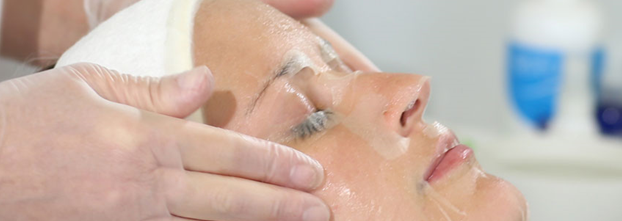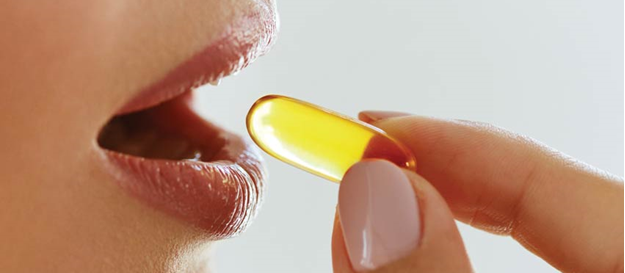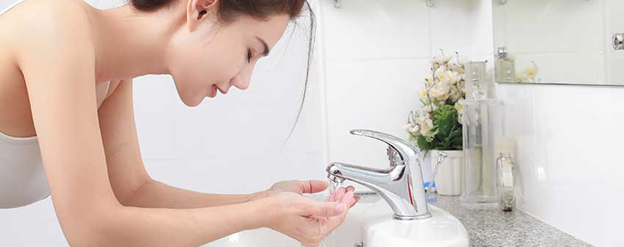Skin Story

I am a skin scientist and beauty therapist, and my approach to skin care has always been evidence-based, yet natural. I believe that effective results can be achieved using a subtle approach. This includes monitoring an individual’s progress over time and should take the following factors into consideration: age, skin type and concerns, seasonal and hormonal changes, health, lifestyle and budget, and skin care application techniques. Correct skin type diagnosis is the first step toward achieving the results for client. I respect the powers of plant materials in skin care and their benefits to skin, recommending organic and natural skin care where appropriate.
Enzymatic exfoliation is a plant active based therapy. Enzymes have a proteolytic effect and induce superficial exfoliation on the cells of the stratum corneum. Enzymatic exfoliation has seen a slight decline lately, but it has a place, in particular for those skin types where mechanical and alpha hydroxy acid (AHA) exfoliation is too strong.
Exfoliation and Enzymes
While the skin naturally sheds superficial skin cells (corneocytes), this shedding process slows down with age, and an irregular build-up leads to patches of dull skin and an uneven complexion.
Most clients are familiar with mechanical exfoliation from scrubs like oatmeal, coffee, polyethylene or jojoba beads in addition to chemical exfoliation from AHAs like lactic, glycolic and azelaic acid. Few, however, are aware of enzymatic exfoliators, which are particularly beneficial for resilient oily and mature skin types. While mechanical exfoliators physically remove dead skin cells, chemical and enzymatic exfoliators work on the bonds, which hold the skin together.
Exfoliating enzymes remove the dry superficial, dull skin cells (corneocytes) by digesting the proteins of the stratum corneum into smaller fragments, preventing a build-up.
Enzymes can work more gently than AHA in breaking down the bonds, which hold shedding skin cells together and accelerate the skin’s natural exfoliation process. This is because they are activated by water and not pH and they are limited in the exfoliation they can achieve. They can prevent the increased keratinization around follicles, which block sebum flow and create blackheads in acne.
Benefits of Enzymatic Exfoliation
Regular exfoliation achieves a smooth and radiant complexion. Similarly, skin treated with enzymatic exfoliation is instantly brightened and smoothed.
There is a mild hydrating and antibacterial effect, making enzymatic exfoliation a good choice for the oily and mature skin. Exfoliation is also known to promote better absorption of skin care products.
Scientific studies confirm the application of a 15% enzyme serum and moisturizer twice daily for three months improved the appearance of skin over time compared to controls.1 The improvements included changes in skin smoothness and texture, the depth and number of lines and wrinkles, and epidermal and dermal firmness and thickness. The improvements were reported to be similar to results observed with higher concentrations of AHAs.
Types of Enzymatic Exfoliants
The most well-known of these exfoliators are naturally derived from pineapple and papaya. Pineapple contains bromelain, the strongest enzyme originally used in wound healing.
Papain is an enzyme found in unripe papayas. There is not much data supporting the efficacy of papain in skin care. However, there is a research into the effect of topically applied proteases in soap-induced dry (xerotic) skin. Papain has induced the degradation of the cell-binding desmosomes, which promote desquamation. This has significantly and rapidly reduced the visual scaling associated with dry skin. Pumpkin also contains the exfoliating enzyme protease.2
A significant benefit of fruit enzymes is the antioxidant vitamins they supply as they exfoliate. For example, pineapple contains vitamin C.
Sensitivity and Allergy
Exfoliation should not be used to treat sensitive skin, particularly those with broken capillaries (teleangiectasia) and oily skin with a weak barrier function. If there is any feeling of burning or irritation, the product has to be rinsed off immediately.
It is important to avoid the delicate eye zone and a shorter application is advisable at first. If tolerated, the typical 15-20 minute application can follow.
The issue of allergic reaction to papain was covered in the news recently. Austrian research published in the Journal of Investigative Dermatology 3 found papain induces a specific allergic sensitization, i.e. breakdown of cell-cell junctions in the epidermis, a loss of barrier function, increased vascular permeability and influx of inflammation in animal models. Therefore, enzymatic exfoliation is contraindicated in people prone to skin conditions such as atopic dermatitis with increased permeability of the skin and increased risk of allergy.
Risk/Benefit Assessment
It is a part of the beauty therapist’s professional judgment to assess the risk/benefit of enzymatic exfoliation for each client, but compared to mechanical exfoliation, it can be more even and controlled.
Enzymatic exfoliation is beneficial for resilient skin types, where removing the shedding top layer of skin evenly leads to a lighter and more radiant skin with a smooth, more uniform texture and stimulates the skin renewal.

Repêchage recently debuted their new Peel and Glow Facial treatment on March 3, 2018. This facial treatment is designed to exfoliate, hydrate and brighten the skin. This 45 minute treatment can be used on all skin types and is recommended to be done once a week for six weeks and then monthly.
The Peel and Glow Facial
Step 1. Cleanse the client's skin from any makeup and residue, and remove any excess product with a cotton pad that has been dampened with warm water. Pat dry.
Step 2. Apply Repêchage's Biolight Luminex Mask or another clay-cream based mask that can provide the skin with a peel effect. Apply the mask by dumping the contents into a bowl and applying it with a brush to the face, neck and décolleté. Leave on for 10 minutes before removing and patting the skin dry.
Step 3. Apply Repêchage's Triple Action Peptide Mask or a sheet mask of your choosing that works to hydrate, brighten and firm the client's skin. Adjust the mask to fit tightly on the contours of your client's face and leave this on for 10 to 15 minutes.
BONUS. Use galvanic iontophoresis current for seven minutes and leave the mask on for an extra five minutes.
Step 4. Remove the sheet mask and perform a 10-minute facial massage on the clients face to work the serum on the mask into the skin.
Step 5. Apply an environmental-defense moisturizer to the skin.

Celebrities can really bring out the unique skin care trends, and most recently blood cream has become the latest and greatest fad. Celebrities like Victoria Beckham, Emma Roberts and Hailey Baldwin have been swearing by the platelet rich plasma (PRP) creams to keep their complexion looking youthful and vibrant.
This personalized moisturizer created by Barbara Sturm, M.D., Ph.D., takes the plasma from an individual's blood and uses that as the key ingredient to the formula. When Victoria Beckham shared about the product in her Instagram story, she explained how the cream uses her blood to create healing factors that provide anti-inflammatory and regenerative benefits.
This isn't the first time blood has been used in skin treatments, with Kim Kardashian making the Vampire Facial all the rage back in 2017, and customized cosmeceuticals is currently a growing trend in the industry.
Whitney Bowe, M.D., dermatologist, explained to Good Morning America the benefits of this type of PRP rich cream saying how "The plasma is the key for the youthful, healthy skin because it's thought to stimulate wound healing and make the skin look and feel younger." She continued on to explain how the growth factors in PRP can aid in tricking aging cells into behaving like young, healthy ones.

Beauty sleep is a real thing. In fact, it is so good for you that it is also one of the wellness trends that have been called out for 2019. Melatonin supplements or foods rich with melatonin are often recommended for people who have a hard time falling asleep at night, but more recently melatonin has entered the spotlight for a new reason. Brands have started using this ingredient topically in skin care lines to provide anti-aging benefits to the skin.
In fact, melatonin has been called out to be a potential trending ingredient for 2019 with brands like ISDIN, Peter Thomas Roth, Dr. Dennis Gross, Murad and Dr. Gerald Imber incorporating it into one or more of the products in their skin care lines.
What is Melatonin?
Melatonin is naturally produced by the brain when it begins to become dark outside, and it signals the body that it's time to go to sleep. The hormone is created by pineal gland, and it's function is to help the body regulate its sleep-wake cycle.
Blue light technology can severely reduce the amount of melatonin that the brain releases before bed time. That is why it is very important to refrain from using devices, like phones, before bed. For people who have a hard time falling asleep, it is often recommended that melatonin supplement be taken, or certain "sleepy foods" be eaten to increase the production of melatonin in the body.
Melatonin's New Purpose
While beauty sleep in a nutshell allows the skin to repair itself, melatonin specifically is being used to help prevent signs of aging on the skin. While skin aging is a complicated process impacted by both intrinsic and extrinsic factors, melatonin's strong antioxidant properties have been shown to protect the cells from aging on a wide spectrum including counteracting solar UV irradiation. To receive these types of benefits to the skin, it has been recommended to use the ingredient topically rather than orally.
"Melatonin is actually highly lipophilic, which means it can easily penetrate into skin cells and impart important cellular functions such as repairing mitochondrial and DNA damage. It also has been shown to upregulate important antioxidative enzymes, which activates further protection against oxidative damage," explains Melissa Kanchanapoomi Levin, M.D., dermatologist and founder of Entière Dermatology.
The clarification here is that melatonin does provide benefits both orally and topically. However, to receive the best anti-aging benefits it can offer, the ingredient needs to be applied topically. Similarly, to induce better sleeping, melatonin should be taken orally.

Sunscreen is considered essential to skin health—it protects against harmful UV rays that can cause damage, cancer and premature aging. But a recent study in The Journal of American Osteopathic Association notes that vitamin D levels—produced when skin is exposed to sunlight—may be getting the raw end of the deal, and that sunscreen use may be a source of widespread vitamin D deficiencies.
Skin synthesizes vitamin D through solar UVB radiation, the factor sunscreen is designed to protect against. This nutrient helps the body absorb calcium, supporting bone health, and fight infection through the immune system, along with aiding muscle and nerve function. A deficiency of this nutrient occurs when one has a serum 25(OH)D concentration below 20 ng/mL (according to the Endocrine Society), as is the case for nearly one billion people worldwide.
“People are spending less time outside and when they do go out, they’re typically wearing sunscreen, which essentially nullifies the body’s ability to produce vitamin D. While we want people to protect themselves against skin cancer, there are healthy, moderate levels of unprotected sun exposure that can be very helpful in boosting vitamin D,” said Kim Pfotenhauer, D.O., a researcher on the study.
"Apprehension about vitamin D status should not be a reason to withhold sunscreen application during extended periods of exposure to strong sunlight." Brian Diffey, Ph.D., D.Sc.
Industry Weighs In
Others in the industry disagree—esteemed sunscreen expert Brian Diffey, Ph.D., D.Sc., notes while some studies have found that a sunscreen application of 2 mg/cm2 resulted in compromised vitamin D production after UV exposure, this only occurs in a laboratory setting. The average person typically applies less than this quantity of sunscreen and does not apply it in a uniform fashion or reapply later in the day.
“It is pure speculation that sunscreen use will lead to widespread vitamin D deficiency and [the authors] present no evidence to support this assertion,” said Diffey.
Diffey also points out that most individuals only apply sunscreen during planned recreational activities, while vitamin D is synthesized in skin every day, regardless of what one is doing in the sun.
“Most people living in temperate climates will not bother applying sunscreen during their adventitious exposure, such as popping out at lunchtime during the work week,” said Diffey. “So apprehension about vitamin D status should not be a reason to withhold sunscreen application during extended periods of exposure to strong sunlight.”
Middle Ground
Pfotenhauer noted that the study is not calling for extended sun exposure without protection, and that “a simple walk with arms and legs exposed is enough for most people.”
Skin care products formulated with UV filters may pose some concern, though, since they protect users against the sun during spontaneous outings. However, Diffey states, there is not sufficient information to support the claim that sunscreen causes vitamin D deficiencies.
The study suggests alternative sources of vitamin D, such as supplements, milk, breakfast cereals and other foods fortified with vitamin D as options to balance out deficiencies, although exposure to sunlight is the most efficient method.

Adequate vitamin D levels are essential for a good treatment outcome. Even when the sun is shining and the weather is warm, a vitamin D deficiency can be a problem for many people. One little known impact of the lack of vitamin D is the integrity of the skin barrier, which can cause issues like increased sensitivity, acne and chronic dryness.
One of the skin’s functions is the synthesis of vitamin D (7-dehydrocholestrol), which occurs in the stratum spinosum and stratum basel. If our skin’s barrier is not intact or damaged, the ability to get optimal levels are also impacted. Even though we refer to vitamin D as an essential part of our diets, it is not a traditional vitamin. The sources are limited in our diet. It really is a fat soluble pro-hormone steroid that effects the endocrine system as well as cell communication and proliferation.
Digital Edition Link: Learn three easy ways to get more vitamin D, and how it can make a big impact in the treatment room by reading the digital edition!

Sensorial design creates an emotional impact perfectly aligned with the booming wellness and self-care movements.
Function, feeling or both? Beauty products have filled myriad needs for consumers over the years, but the two that continually stand out over time are function—for example, related to the benefits they provide to physically improve the skin on the outside—and feeling—related to the pampering, luxury and emotional benefits that the user experiences during use.
While providing both to a consumer is always key, new research suggests that for consumers, the pendulum may be swinging over to the feeling side. According to market intelligence firm Mintel, the Asia-Pacific region—often a barometer for trends on the rise—accounted for a third of 2018’s beauty and personal care products designed to provide de-stressing and relaxation.
Mintel’s senior innovation and insights analyst for beauty and personal care, Sharon Kwek, recently noted in a press release (www.mintel.com) that consumers are looking to address low energy levels and enhance their mood through all of their beauty products: “The beauty routine will transform into a self-care routine, and all categories of beauty will be expected to deliver these benefits.”
Similarly, in Beautystreams’ “Cosmo Trends” presentation at Cosmoprof Bologna, the firm noted that products designed for “instant gratification” for millennial and Gen Z consumers must be “fun to use and play with … inspire self-expression and offer irresistible sensorial experiences.”
The report added that, in the high-innovation space of wellness-inspired intimate care, products are designed with enhanced self-care in mind, featuring “luxurious formulas, sensorial experiences and high-quality natural ingredients,” as well as “elevated positioning on par with premium skin care, boasting elegant packaging and aesthetics that encourage display on bathroom shelves.”
As such, it’s no surprise that top brands and suppliers are aligning to provide beauty and personal care designed to engage all the senses.
Want to read the full article? Check out the April 2019 digital edition of Global Cosmetic Industry magazine.

What happens when nature-inspired earth tones meet high-tech science hues? Well, come 2020, the world is going to find out. WGSN's Beauty Global Color forecast has presented three seasonal vision trends for the beauty industry, applicable for cosmetics, hair and packaging.
According to the trend forecasting company, Spring/Summer 2020 will shift away from mid-tones and neutrals to begin focusing on cooler, futuristic hues that signify a new decade. At the same time, warm, earthy and relatable tones will remain in vogue by acting as a sort of antidote to the digital world's overwhelming influence on society.
Top trends include:
- Muted tones: Taking a page from the ever-present millennial pink, pale mint and soft orange colors are "transseasonal, versatile and gender neutral," according to WGSN, and are ideal for summer collections.
- Bright citrus hues: Shades of orange and yellow are expected to move from niche beauty segments to the mainstream in 2020. Variations on these tones are expected to have "cross-generational appeal."
- Earthy reds: Spring/Summer 2020 will take the classic red hue and turn it on its head with deep, earthy tones and russet influences. Expect to see this color used not only on the lips and cheeks but on the eyes as well.
- Clinical influences: Cool, almost clinical blues and greens will offer a futuristic alternative to traditional summer colors, WGSN explained.
As millennial and Gen Z consumers steadily gain purchasing power, product and packaging colors will continue to reflect what attracts these generations: self-expression, quirky influences and bold visuals.

Any given personal care product makes many stops on its way to the consumer; from the laboratory, to the retail setting, etc. But the journey does not end once a product is purchased and used—trace amounts go on to enter waterways. While these initial ingredients may have proven safe, a new study suggests their partly decomposed by-products are an unknown.
Small amounts of personal care and pharmaceutical ingredients in the body are transferred to sewage treatment plants, streams, rivers, lakes and the ocean through wastewater, according to a recent study published in Environmental Toxicology and Chemistry
Specifically, Rutgers scientists tested the bacteria in sludge from a sewage treatment plant for the ability to break down two personal care ingredients and two pharmaceutical products: oxybenzone; a sunscreen ingredient; methylparaben, a preservative; naproxen, an anti-inflammatory drug; and guaifenesin, an expectorant. Results showed that while the bacteria broke down methylparaben, oxybenzone and both pharmaceutical products were only partially broken-down. The resulting materials create new contaminants in waterways, according to the researchers.
"Our findings can help us assess other widely used pharmaceutical and personal care products with similar chemical structures. By predicting or assessing the chemicals that might form during the breakdown process, we can identify and quantify them in the environment," said Lily Young, co-author, distinguished professor in Rutger's Department of Environmental Sciences.
Contaminants such as those studied have been increasingly detected at low levels in surface water, and may have an impact on health, according to the U.S. Environmental Protection Agency. Future research on the topic will evaluate long-term persistence of the transformed chemicals from various environmental locations.
Industry Implications
These findings of contaminants in waterways bring to mind research that has sparked debate and led two U.S. legislative bodies to ban the sunscreen ingredients oxybenzone and octinoxate from areas near coral reefs; in that context, the materials were said to enter and damage coral reef ecosystems after swimmers wore them in nearby water.
While the details vary in ingredients and products, the end result may be the same. Will the cosmetic industry see regulatory action in response to the claims that personal care ingredients may affect waterways? Follow Cosmetics & Toiletries as we watch for larger implications of these findings.
Read the study at www.news.rutgers.edu

Skin care products are blurring lines between traditional concepts and innovative, effective new uses. In an exclusive interview, Janna Ronert, founder of Image Skincare, shared ingredient and concept picks that she believes will make the move from trends to staples in professional skin care formulas.
Retinols
Retinol works to improve lines and skin discoloration, while retinoids promote cell turnover to increase collagen production. Both, however, are derived from vitamin A.
“What has always been a staple but will continue to grow is the use of retinol, retinoids and vitamin A. … The ability to formulate these very high potency ingredients now in a form that isn’t as irritating as they have been in the past will continue to be a staple in people’s diets,” said Ronert.
Vitamin C
Vitamin C is known for its antioxidant protection, especially important to today’s consumers concerned about the effects of air pollution. The vitamin also boosts collagen production and can play a role in epigenetic regulation.
Ronert noted that “Now [vitamin C can be] oil-soluble, it can be water-soluble and you can mix vitamin C with a whole host [of ingredients]. Vitamin C is definitely on the rise, both in ingestibles and topically.”
Multitasking Products
In contrast to trendy K-Beauty rituals, which typically involve a regimen of several skin care products that work together, Ronert predicted products that serve more than one purpose will gain traction.
“You’re going to see less steps and more multitasking of products, which is great for the consumer because it is less products, less money and bigger bang for your buck. That's where I see the vision of skin care going—where certainly one bottle can't do it all, but formulators and professional skin care companies can put a lot into one bottle today,” said Ronert.

In the past, atopic dermatitis (AD) has been associated with psychological distress, and a group of researchers dug deeper into this topic to understand and determine the complex relationship between AD and depression. The article discussing how AD may be associated with increased depression and suicidality was published in the Journal of the American Academy of Dermatology.
The Study
The group of researchers performed a systematic review that analyzed depression in AD through observational studies that had been published in MEDLINE, Pubmed, EMBASE, GREAT, LILACS, Cochrane Library, Scopus and PsychInfo. Two reviewers performed a review and data abstraction of the information that was collected and also conducted a pooled meta-analysis using random-effects weighting. The study had one key limitation of not being able to collect data on an individual level.
Conclusions
The researchers found that 106 of the studies met the inclusion criteria with 36 of the studies having sufficient data for meta-analysis. People who had AD showed that they had a 20.1% chance of having depression, while people who did not have AD only had a 14.8% chance of having depression. It was also shown that AD was associated with higher depression scales, parental depression, anti-depressant use and suicidality.


-1.jpg) Face Lotion
Face Lotion-1.jpg) Body Lotion
Body Lotion-1.jpg) Hand Lotion
Hand Lotion-1.jpg) Foot Lotion
Foot Lotion(DK)-1.jpg) Special Gift Set
Special Gift Set.jpg) Amazon
Amazon eBay
eBay Order with Check by Email
Order with Check by Email



